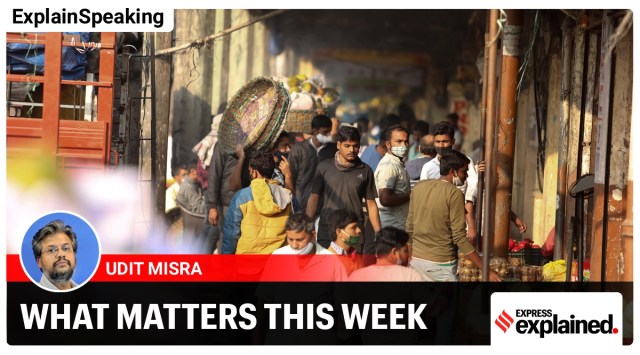- India
- International
ExplainSpeaking: Why RBI is likely to cut GDP growth forecast and raise interest rates
Six percent is emerging as the key macro number to watch out for in the lead up to the next general elections in 2024. The RBI cannot allow inflation to soar above it and the government cannot allow the GDP growth rate to fall below it.
 By law, retail inflation can deviate from 4% but not breach the 2% to 6% comfort zone. In pic, sellers line up at a vegetable market. (Express file photo by Narendra Vaskar)
By law, retail inflation can deviate from 4% but not breach the 2% to 6% comfort zone. In pic, sellers line up at a vegetable market. (Express file photo by Narendra Vaskar)ExplainSpeaking-Economy is a weekly newsletter by Udit Misra, delivered in your inbox every Monday morning. Click here to subscribe
Dear Readers,
This week, between September 28th and 30th, the RBI’s Monetary Policy Committee (MPC) will meet again and recalibrate India’s monetary policy stance.
Like always, the two key things to watch out for will be :
1) What happens to interest rates?
2) What happens to GDP growth projections?
Why interest rates (read your EMIs) are likely to go up further
There are two broad reasons why RBI will hike interest rates this week.
One
By law, the RBI is required to prioritise maintaining price stability. Simply put, it is legally required to target a retail inflation rate of 4%. It has been given a leeway of two percentage points on either side. In other words, retail inflation can deviate from 4% but not breach the 2% to 6% comfort zone.

The RBI is already behind the curve. Since the start of 2022, inflation has been above the 6% mark in each of the three quarters. What’s more, even by RBI’s projections, retail inflation is likely to be 6.7% for the financial year ending in March 2023.
This was one of the primary reasons why the RBI started hiking interest rates in May this year. Read this piece to know more.
Since May, RBI has raised interest rates by 140 basis points; 100 basis points make a full percentage point. As such, the repo rate (or the rate at which RBI loans money to the banking system) has gone up from 4% to 5.40%.
Yet, inflation remains stubborn. After climbing to 7.8% in April — the highest since Prime Minister Narendra Modi took office in 2014 — it simmered down a bit but never fell below 6.7%. In August, it climbed back to 7% and there is a very good chance that it may clock an even higher number in September. This is the first reason why RBI will continue to raise interest rates.
Two
The second trigger to raise interest rates comes from the actions of the US central bank. The US has been facing very high inflation — it had gone above 9% in June — even though the Federal Reserve targets an inflation rate of just 2%. The Fed has been aggressively raising interest rates in a bid to cool down inflation. Last week, it raised the interest rates by 75 basis points — the third successive hike of this magnitude this year.
The Fed hopes that such sharp increases in the interest rate will persuade Americans to cut down on credit-financed spending, thus cooling down the spiralling price rise.
While these rate hikes by the Fed are pushing the US economy towards a possible recession, they are also creating havoc in emerging market economies such as India.
Here’s how: When the US had low interest rates, global investors could borrow money at almost zero interest rate and invest in emerging economies such as India. When the US raises interest rates, that incentive changes direction; money tends to get pulled out of economies such as India. When that happens, the rupee’s exchange rate vis-a-vis the US dollar starts to plummet.
It is also important to remember here that regardless of the Fed’s decision, the rupee’s exchange rate faces challenges because India has a rising trade deficit (that is, the excess of imports over exports). A weaker rupee, in turns, implies higher imported inflation because all imports become costlier.
To counter all these reversals, the RBI is forced to raise interest rates.
It is expected that the Fed will likely raise the US interest rates by another 100 basis points (that is, one full percentage point) in the coming months.
Expect the RBI to raise 50 basis points this week, and possibly another 50 basis points in due course. These increases will, in turn, make all loans (be it for a new car or new house this Diwali) costlier.
Why GDP growth estimates are likely to be dialled down
While RBI is getting forced into raising interest rates to contain inflation, the growing worry in the government is about what this will do to India’s economic growth recovery. Read this piece to understand the divergence between the RBI and the government on monetary policy.
Of course, someone can point out that RBI has not altered the GDP growth forecast — 7.2%, to be precise — for the current financial year since April, when this financial year started. But that is where the problem lies.
When RBI projected a GDP growth forecast of 7.2% for 2022-23 in April, its inflation forecast for the year was 4.5%. Since then, the inflation forecast has gone up from 4.5% to 6.7%. In response, RBI has already raised interest rates by 1.4% and there is a very good chance that they will likely go up by another one percentage point in the coming months.
Can the GDP forecast remain the same when both inflation and interest rates have gone up by over two percentage points? Most unlikely.
As explained in the past, higher interest rates tend to drag down economic activity in an economy. Even the government knows this, and that’s why it is worried about the economic growth rate falling to anything less than 6% in the lead up to the next general elections in 2024.
Upshot: Six percent is emerging as the key macro number to watch out for in the lead up to the next general elections in 2024. The RBI cannot allow inflation to soar above it and the government cannot allow the GDP growth rate to fall below it.
What do you think is the bigger concern for Indian policymakers: High inflation or low growth rate (and associated high unemployment)?
Share your views and queries at udit.misra@expressindia.com
Till then, stay safe.
Udit
More Explained
EXPRESS OPINION
Apr 27: Latest News
- 01
- 02
- 03
- 04
- 05











































